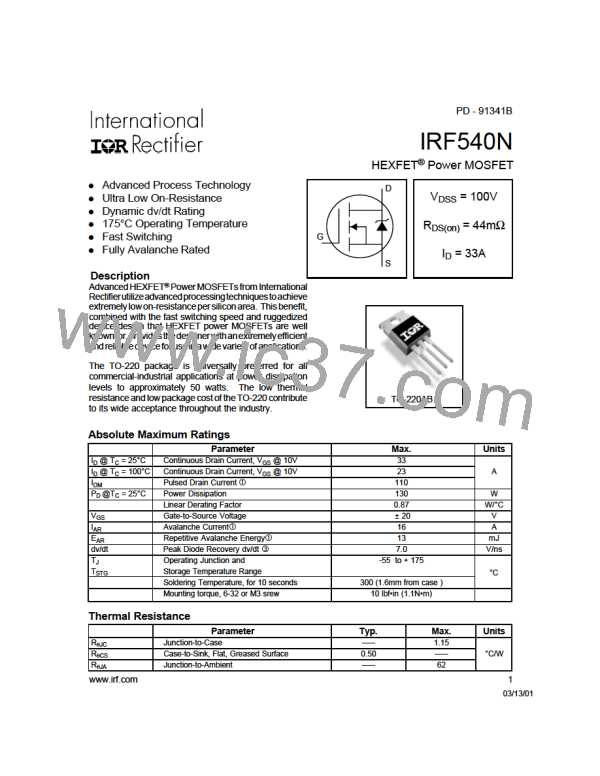IRF540N
Electrical Characteristics @ TJ = 25°C (unless otherwise specified)
Parameter
Min. Typ. Max. Units
100 ––– –––
Conditions
VGS = 0V, ID = 250µA
V(BR)DSS
Drain-to-Source Breakdown Voltage
V
∆V(BR)DSS/∆TJ Breakdown Voltage Temp. Coefficient ––– 0.12 ––– V/°C Reference to 25°C, ID = 1mA
RDS(on)
VGS(th)
gfs
Static Drain-to-Source On-Resistance
Gate Threshold Voltage
––– ––– 44
mΩ VGS = 10V, ID = 16A
2.0
21
––– 4.0
V
S
VDS = VGS, ID = 250µA
VDS = 50V, ID = 16A
VDS = 100V, VGS = 0V
Forward Transconductance
––– –––
––– ––– 25
––– ––– 250
––– ––– 100
––– ––– -100
––– ––– 71
––– ––– 14
IDSS
Drain-to-Source Leakage Current
µA
nA
VDS = 80V, VGS = 0V, TJ = 150°C
VGS = 20V
Gate-to-Source Forward Leakage
Gate-to-Source Reverse Leakage
Total Gate Charge
IGSS
VGS = -20V
Qg
ID = 16A
Qgs
Qgd
td(on)
tr
Gate-to-Source Charge
Gate-to-Drain ("Miller") Charge
Turn-On Delay Time
Rise Time
nC VDS = 80V
VGS = 10V, See Fig. 6 and 13
––– –––
21
–––
–––
–––
–––
11 –––
35 –––
39 –––
35 –––
VDD = 50V
ID = 16A
ns
td(off)
tf
Turn-Off Delay Time
Fall Time
RG = 5.1Ω
VGS = 10V, See Fig. 10
Between lead,
6mm (0.25in.)
from package
and center of die contact
VGS = 0V
D
4.5
LD
LS
Internal Drain Inductance
Internal Source Inductance
–––
–––
–––
–––
nH
G
7.5
S
Ciss
Coss
Crss
EAS
Input Capacitance
––– 1960 –––
––– 250 –––
Output Capacitance
VDS = 25V
Reverse Transfer Capacitance
Single Pulse Avalanche Energy
–––
40 –––
pF
ƒ = 1.0MHz, See Fig. 5
––– 700ꢀ185 mJ IAS = 16A, L = 1.5mH
Source-Drain Ratings and Characteristics
Parameter
Continuous Source Current
(Body Diode)
Min. Typ. Max. Units
Conditions
MOSFET symbol
D
IS
33
––– –––
––– –––
showing the
A
G
ISM
Pulsed Source Current
(Body Diode)
integral reverse
p-n junction diode.
110
S
VSD
trr
Diode Forward Voltage
Reverse Recovery Time
Reverse Recovery Charge
Forward Turn-On Time
––– ––– 1.2
––– 115 170
––– 505 760
V
TJ = 25°C, IS = 16A, VGS = 0V
TJ = 25°C, IF = 16A
ns
Qrr
ton
nC di/dt = 100A/µs
Intrinsic turn-on time is negligible (turn-on is dominated by LS+LD)
Notes:
ISD ≤ 16A, di/dt ≤ 340A/µs, VDD ≤ V(BR)DSS
,
Repetitive rating; pulse width limited by
TJ ≤ 175°C
max. junction temperature. (See fig. 11)
Pulse width ≤ 400µs; duty cycle ≤ 2%.
Starting TJ = 25°C, L =1.5mH
ꢀThis is a typical value at device destruction and represents
operation outside rated limits.
RG = 25Ω, IAS = 16A. (See Figure 12)
This is a calculated value limited to TJ = 175°C .
2
www.irf.com

 INFINEON [ Infineon ]
INFINEON [ Infineon ]